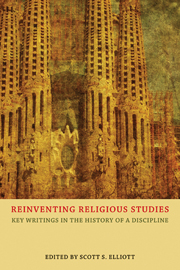Book contents
- Frontmatter
- Contents
- Introduction
- 1 For such a time as this: the Council of Societies for the Study of Religion, 1969–2009
- Part I Inventing and reinventing the field of religious studies
- 2 Why a Council on the Study of Religion?
- 3 Ironies
- 4 Religious studies: the next vocation
- 5 Impressions from Wingspread: religious studies—the state of the art
- 6 History of religions
- 7 The future of religious studies: moving beyond the mandate of the 1960s
- 8 Naming the game: a question of the field
- Part II Method and theory in religious studies
- Part III Teaching religion
- Part IV Women and the bible in religious studies
- Part V Religion and religious studies in civic life
- Part VI Religious studies and identity politics
- Part VII Islam and 9/11
- Bibliography
- Acknowledgments
- Index
3 - Ironies
from Part I - Inventing and reinventing the field of religious studies
- Frontmatter
- Contents
- Introduction
- 1 For such a time as this: the Council of Societies for the Study of Religion, 1969–2009
- Part I Inventing and reinventing the field of religious studies
- 2 Why a Council on the Study of Religion?
- 3 Ironies
- 4 Religious studies: the next vocation
- 5 Impressions from Wingspread: religious studies—the state of the art
- 6 History of religions
- 7 The future of religious studies: moving beyond the mandate of the 1960s
- 8 Naming the game: a question of the field
- Part II Method and theory in religious studies
- Part III Teaching religion
- Part IV Women and the bible in religious studies
- Part V Religion and religious studies in civic life
- Part VI Religious studies and identity politics
- Part VII Islam and 9/11
- Bibliography
- Acknowledgments
- Index
Summary
Surely the gods are laughing, for they must enjoy ironies—especially concerning man's study of his religions. In a word, the design for development of this field, so carefully planned during the last decade, now seems faintly anachronistic, even quaint, even while it comes to fruition (as in this present publication). The times appear to pass us by, and that on two separate levels: (1) Established disciplines within the arts and sciences no longer seem such secure, self-evidently appropriate models for developing religion programs or departments, and (2) Many among the abler students no longer appear to value critical study of religious materials. How shall we comprehend these matters? What is the force of each?
During the 1960s great attention was devoted to the definition of religion study to facilitate its development within the context of the arts and sciences. That context appeared secure. Departments, based upon conjunction of subject matter and appropriate method(s), constituted the unquestioned university firmament. The study of religion was to be secured within that setting. Thus some greater objectivity, less special pleading, would qualify it for a place beside the established approaches to cognate materials.
That context currently appears problematic, for the fixed firmament of disciplines seems now in disarray: Scientific procedures—the acknowledged model? Objectivity—the goal? What field, however long established, is not now wracked with the self-doubt of its sensitive younger practitioners (men and women)—in and with whom, inevitably, the future lies?
- Type
- Chapter
- Information
- Reinventing Religious StudiesKey Writings in the History of a Discipline, pp. 34 - 37Publisher: Acumen PublishingPrint publication year: 2013



